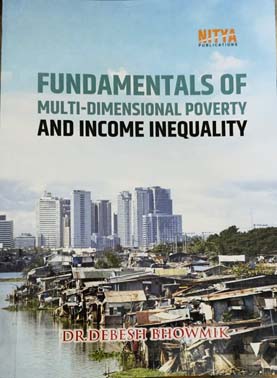The book ‘Fundamentals of Multi-dimensional Poverty and Income Inequality’ consists of two sections. In section I, the multi-dimensional poverty index was developed and in section II, the income inequality was discussed. Multi-dimensional poverty index was explained in chapter-1while world income inequality, its nature, trends and policies was discussed in chapter-2,income inequality in high income economies in chapter-3,income inequality in middle income economies in chapter-4,income inequality in African countries in chapter-5,income inequality in South Asian countries in chapter-6 were described. In chapter-1, the concept, measurement, relation between multi-dimensional poverty index and growth, multi-dimensional poverty index and inequality, rural and urban multi-dimensional poverty index, global multi-dimensional poverty are the central areas of study where region-wise and country-wise empirical findings have been included. Some important researches on multi-dimensional poverty and policy recommendations are also included. India’s multi-dimensional poverty index decomposing into all Indian states and the districts of West Bengal were studied exclusively under comparative analysis during the period between 2015-16 and 2019-21. India sets 17 sustainable development goals in connection with the UNDPs SDGs in which India’s SDG-1to SDG-6, SDG-10 and SDG-13 are directly and indirectly related with multi-dimensional poverty index of India by which poverty alleviation can be implemented easily. All these goals vis-à-vis MPI were scrutinised in this chapter exclusively so that researchers and students can easily understand the nature of income inequality and can frame policies by themselves. As regards policies, critical analysis, modifications and suggestions, huge literatures have been incorporated to innovative studies. Some comments on the part of international institutions were added. Policy makers can easily access their preventive measures verifying the MPI and their deprivations in a separate country, state or district like India.
In section-II, USA, UK, France, Germany, Australia and Canada are taken as high-income economies. Brazil, China, Mexico, Malaysia, Russia have been considered in middle income economies. Burkina Faso, Botswana, Cote d Ivorie, Mauritania, Niger, Nigeria, Senegal, Uganda, South Africa and Zambia were included in African Countries. India, Bangladesh and Pakistan are considered in South Asian countries. Considering world inequality data, all the countries’ income inequality trends (linear or nonlinear), cyclical trends during long periods (more than 50 years) have been found out from the difference of top 10% of income shares and bottom 50% of income shares. The patterns of income inequality, causes of income inequality and the respective policies taken by the above countries have been analysed carefully. Huge literature reviews were incorporated for all countries as well as global economy as a whole with supporting evidences as figures. Author has finally concluded for all chapters as follows.
The Gini coefficient of the world has been increasing from 1820 to 1910 followed by a stability over 1910-2000 and then started to fall till 2020 while in HP filter model showed that the long-term cyclical trend of inequality is inverse U shaped but under Hamilton filter model, the cyclical trend during 2000-2014 and 2017-2021 are downswing along with two upswings and its course towards 2050 remains stable.

In the high income economies, the long run gap of income shares between top 10% and bottom 50% in Australia and USA showed U shaped and their forecast paths towards 2050 are converging or downwards which implied inequality is declining while in UK the trend is inverse U shaped and inequality tends to fall till 2050.In Germany, inequality is rising the journey towards 2050 is cyclical while Canadian inequality remains stable till 1990s and then started to increase which looks like a flatter S where its course to 2050 is downswing.
In the middle-income economies, the long run income gap between the richest 10% and the poorest 50% during 1980-2021 in Russia is upward till 1998 followed by a stable inequality while in Brazil inequality is falling during 1980-2011 followed by an increasing trend and up to 2050 it is convergent. Chinese income inequality has been rising till 2005 followed by a downswing up till 2016 and then started to fall till 2050.The cyclical trend of inequality in Mexico during 1990-2010 has been rising followed by a declining trend till 2017 and then started to increase. On the other hand, Malaysian inequality has been declining during 1998-2016 followed by an upswing trend till 1998 and then remain stable over 2050.
In African countries, inequality through Gini index have been falling during 1990s, and 2000s significantly especially in Burkina Faso, Mauritania, Senegal, Niger and Nigeria while Gini index has been increasing in South Africa even in Botswana and Uganda it is inverse U shaped and in Zambia it is flatter U shaped. Gini index showed cyclical in Cote d Ivorie. So that African inequality is gradually improving however recent data are unavailable.
In South Asia, India’s long term inequality trend is strongly upswing during 1976-2010 then started to decline although it consists of 4 peaks and 4 troughs during 1950-2021 while its forecast path towards 2050 remains convergent and dwindling inequality. On the other hand, Gini index of Bangladesh during 1983-2021 has been declining significantly but its income gap between top 10% and bottom 50% have been showing upward followed by a downswing from 2010. In Pakistan the trend of Gini index during 1987-2021 has been falling significantly while the income gap between top 10% and bottom 50% during the above period revealed flatter U shaped. So that policies on SDGs will be beneficial in South Asian countries to reduce income inequality.
All the readers can read this book. However, the students and researchers who are interested in poverty and inequality will surely benefit from it as a reference.
FUNDAMENTALS OF MULTIDIMENSIONAL POVERTY AND INCOME INEQUALITY
BY DEBESH BHOWMIK
(NITYA PUBLICATIONS, BHOPAL, M.P., INDIA, www.nityapublications.com;91-9009291840,Pp230, MRP-450/-,2023).




